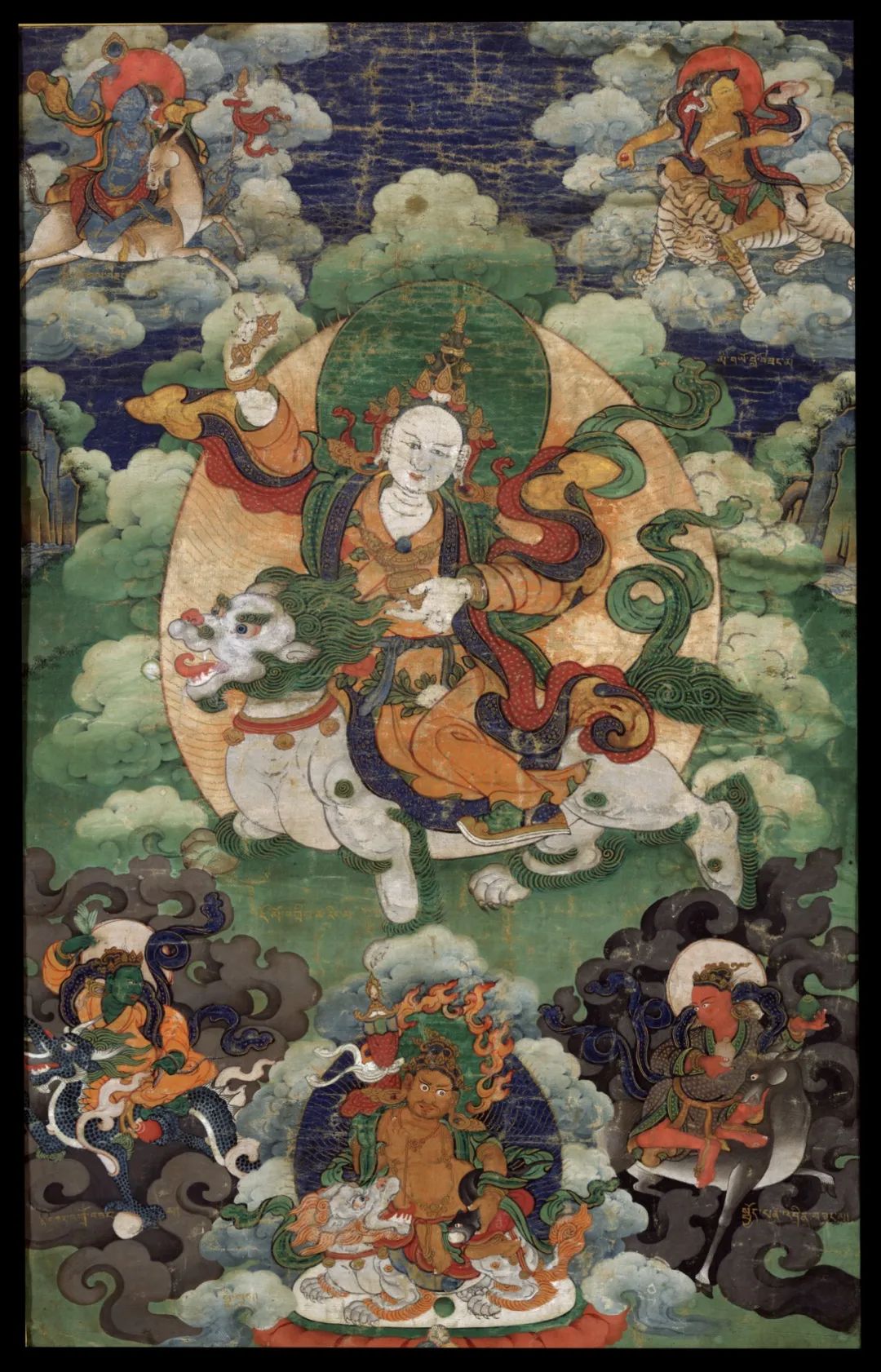
Sacred Mountains and Holy Lakes in Tibet (Part 1) : Summary and explanation

"Yamdrok Lake", 1900-1901
Filmed by Cui Bikof and Norzunov
བེའུ་ལུག་ཕྱྭ་གཡང་རྨ་གཡང་ཚོགས།
མ་ལུས་བྱ་རྣམས་སྐད་སྙན་སྒྲོག།
རྩ་བ་བརྟན་ཅིང་བྱིན་ལེགས་མཛེས།
མཚོ་སྨན་གངས་སྨན་མང་པོ་འདུས།
མཛེས་པའི་འཇའ་ཚོན་སྣ་ལྔས་བརྒྱན།
ཝ་དང་སྟག་གཟིགས་གཅན་གཟན་ཚོགས།
ཞྭ་གོས་སྤྲིན་དཀར་ན་བཟའ་མནབས།
Cattle and sheep thrive bring good fortune
Livestock multiply bring blessings
Birds sing in harmony with outstretched necks
Mountains stand firm and majestic
Herbs grow abundantly by the lake
Beautiful rainbow as decoration
Foxes, tigers, leopards and other wild animals come
Wearing rainbow-colored clothes with clouded hair
From "Sikula Mountain God Praise"
(སྐུ་བླའི་བསྟོད་པ་ཆེན་མོ་)
*The term "Sikula" is a misinterpretation of the Chinese characters for "four sisters," which is the correct translation
These types of translation errors have led to many amusing interpretations.
The sacred mountains and holy lakes within sight are the core landscape combination of the Tibetan Plateau, serving as important objects for people living in this remote natural environment to imagine and practice. They are also spiritual monuments that enable us to achieve cultural coherence. The sacred mountains and holy lakes are symbols that guide people to uncover the most hidden histories, with the boundaries between the known and unknown guarded by the mountains and lakes. The wind in the valleys carries the echoes of the past, while the reflections on the shores of the lakes still show the figures of ancestors, whether they were kings, philosophers, farmers, or herdsmen. The mountains and lakes gather the memories of families, clans, and even dynasties.
Looking up from below at the sacred mountain or wandering by the side of the holy lake, one can witness countless cultural scenes and blessed relics along the specific pilgrimage paths. Classic literature and folk tales intertwine at the foot of the sacred mountain, while history is nurtured in the embrace of legends. Deities can be seen dwelling on the summit of the sacred mountain or in the center of the holy lake, where the mundane family relationships are materialized and projected onto the sacred mountain and holy lake, with the physical bodies composed of rocks, water ripples, vegetation, and animals guarding the villages and pastures.
The communities of the Tibetan Plateau, made up of sacred mountains and holy lakes, have now fallen into an eternal cycle of return: the sacred mountains and lakes are timeless, while our own mortality is forever bound by time. We come and go, constantly revisiting the ancient and unchanging mountains and lakes, our voices echoing with a hint of sorrowful songs. As we rationalize the transcendent sacred relationships, the sacredness is shifting towards its creators, and we continue to live in a world of illusions.

"The Five Sisters of Longevity", 19th century, collection of the Rubin Museum.
The most well-known mountain deity combination in Tibet is the Five Sisters of Long Life, whose imagery and texts were first integrated in the 12th century and later extended into six core worship systems. The central figure is the Goddess of Longevity (བཀྲ་ཤིས་ཚེ་རིང་མ་).

Local: Emerald Beauty (མཐིང་གི་ཞལ་བཟང་མ་; Main Deity of Everest)

Local: Virtuous Woman(མི་གཡོ་གླང་བཟང་མ་)
"People are exceptionally efficient at creating symbols" (Rilke), and mountains and lakes, as visible cultural projections, are highly revered worldwide. In Tibetan areas, sacred mountains and lakes typically have threefold identities: individual identity (great natural features), spiritual identity (deities in the religious system), and ritual identity (blessed by rituals). The natural features of mountains and lakes, with their personalized characteristics as mountain deities or lake spirits, and their relationship with the local community (not always ancestors), give them individual identities. Mythological rhetoric with regional characteristics is applied to mountains and lakes, transforming their identity into a fixed background: a native regional symbol (such as some sacred mountains in Western Tibetan areas).
Under the integration of grand history and established religions, the sacred mountains and lakes began to be endowed with complete personalities, known as mountain gods or lake gods (collectively referred to as domain gods; ཡུལ་ལྷ་). It is important to note that not all sacred mountains and lakes will be shaped as deities, and the image of deities does not necessarily begin with the worship of natural forms (there can be feelings of displacement). There is also no hierarchy between mountains and lakes, and the process of lake gods being attached to mountain gods is very long. Once the sacred mountains and lakes gain their spiritual identity, discussions and debates about their spiritual and physical aspects are brought to the forefront.
The regenerated state of the sacred mountain and lake is no longer just an object of emotional attachment for people. They are gradually transforming into carriers of order and law, incorporating punishment mechanisms into their "daily lives." Ultimately, the appearance of classics completely liberates the image paradigm of the sacred mountain and lake, with regeneration becoming a kind of cyclical state. People constantly add to the ritual identity of the sacred mountain and lake through their actions, from sounds to footsteps, blending natural and human characteristics in a highly unified way.

Local: Coronation Songstress(ཅོད་པན་མགྲིན་བཟང་མ་)

Local: Sherin Lhamo(གཏལ་ཀར་འགྲོ་བཟང་མ་)
I will use the following two articles to elaborate on the sacred mountain and holy lake system in Tibet, specifically highlighting its unique aspects beyond the general mountain and lake culture. Different concepts of mountains and lakes correspond to different types of natural landscapes, with similar mountains and lakes having stable symbolic groups. The personification of mountains and lakes has undergone a process of transformation within specific historical contexts and aesthetic processing, moving from individual worship to how to present specific philosophies of existence and concepts of power, and how sacred origins become mixed and diversified. While the distance between us and sacred mountains and holy lakes may seem vast, we must not forget that all beings are under their watchful gaze. How should we view sacred mountains and holy lakes? How can we understand the meaning of our existence on this blue planet?

